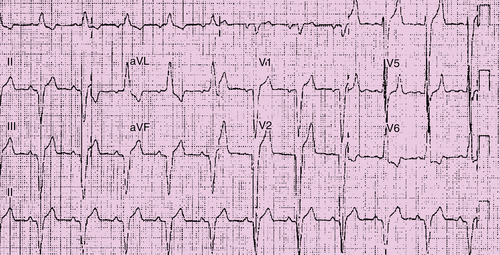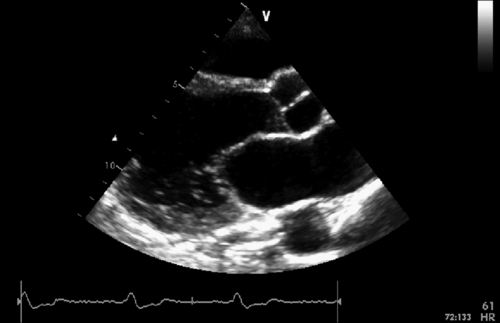History
The patient was diagnosed with myasthenia gravis at the age of 40 years. He reported no cardiologic symptoms until January 2009, when he started experiencing dyspnea on effort. In May 2009 he patient was hospitalized because of congestive heart failure; the echocardiographic examination revealed severe left ventricular dilation and dysfunction. Diuretics and angiotensin-converting enzyme inhibitor therapy were started during the hospitalization, and the patient’s condition improved.
The next month the patient was admitted to our hospital for a complete diagnostic workup and therapeutic optimization.
Comments
An association between myasthenia gravis and giant cell myocarditis has been described in the literature. Giant cell myocarditis is a severe autoimmune disease, and anticardiac antibodies have been demonstrated in the serum of affected patients; it is frequently associated with other autoimmune conditions, such as systemic lupus erythematosus, thyroiditis, polymyositis, and myasthenia gravis. Although the pathogenesis is poorly understood, the overall mechanisms for the generation of autoantibodies in giant cell myocarditis include self-sensitization to cardiac antigens in the thymus, production of self-reactive T cells, stimulation of B cells, production of cardiac autoantibodies, and myonecrosis. These antibodies include anti-titin, anti-ryanodine, anti–alpha actinin, anti-actin, and anti-myosin.
Current Medications
The patient was taking captopril 25 mg three times daily, furosemide 50 mg once daily, digoxin 0.125 mg once daily, potassium canrenoate 25 mg once daily, warfarin 2.5 mg once daily, pantoprazol 40 mg once daily, pyridostigmine bromide 60 mg once daily, prednisone 12.5 mg every other day.
Comments
Beta blocker therapy was contraindicated because of the myasthenia gravis.
Current Symptoms
The patient was experiencing dyspnea on minimal exertion (New York Heart Association [NYHA] class III).
Physical Examination
Comments
The patient had no clinical signs of pulmonary or systemic congestion.
Laboratory Data
Electrocardiogram
Findings
The electrocardiogram (ECG) showed sinus rhythm and complete left bundle branch block (Figure 39-1).
Comments
The ECG clearly suggested the possibility for performing cardiac resynchronization therapy (CRT).
Echocardiogram
Findings
The echocardiogram revealed a left ventricular end-diastolic diameter of 70 mm, end-systolic diameter of 68 mm, mitral annulus diameter of 36 mm, tenting length of 14 mm, and tethering area of 4 cm2 (Figure 39-2). 
Comments
The patient had severe left ventricular dilation and dysfunction, with tethering of the mitral papillary muscles and dilation of the mitral annulus (see Figure 39-2).
Findings
The echocardiogram showed a left ventricular end-diastolic volume index of 178 mL/m2, left ventricular end-systolic volume index of 149 mL/m2, left ventricular ejection fraction (LVEF) of 16%, and functional mitral regurgitation of ++/++++.
Findings
The time delay between anteroseptal and posterior segments at speckle-tracking radial strain analysis is 300 ms (Figure 39-5).3





